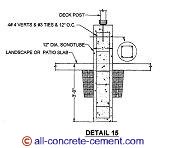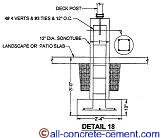concrete pier footing
Question:
Answer:
A pier footing is often higher than it is wider and longer. As shown on details 15 and 18 below, the pier is the vertical portion of the footing. The most common shape of pier footings are circular and rectangular.
The benefit of circular piers is you can use sonotubes to pour versus rectangular you have either rent forms or build your own forms from scratch that can be very costly and time consuming. If you have a project that calls for rectangular piers, you might consider requesting from the engineer to change the design to circular. I don't see any reason why any engineer will object to changing to circular. In fact most blue prints nowadays include alternate designs of concrete piers where both rectangular and circulars are acceptable to use.


A sonotube can be purchased from any home improvement retail store, cut to the length you need, place it where you need and pour. The biggest challenge working with sonotubes they need to be held in place during the pour to make sure they don't move.
Pier footings are very common for decks, sign posts, fence posts, electrical posts and structures that do not have a lot of vertical load. The reason pier footings are common at electrical and sign post they perform well at wind load.
Detail 18 is an example of how pier footing can be used to support heavy load. This is very common at commercial structures and bridges at cold weather regions where the footings are required to be at certain depth. In this type of application, sonotubes can be used on top of the footing as shown in the detail.
Join in and write your own page! It's easy to do. How? Simply click here to return to Got Question?.